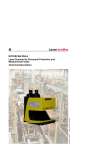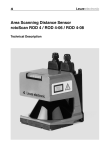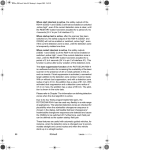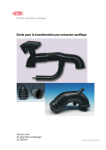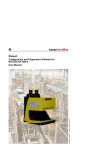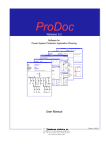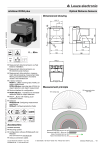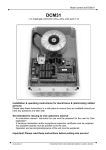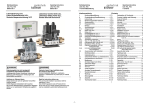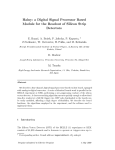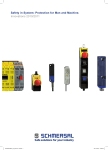Download TNT 35 user manual komplet
Transcript
Leuze electronic Test monitoring units TNT 35 and TNT 35/7-24V User Information All rights reserved, especially the rights of production, distribution and translation. Duplication or reproduction in any form (print, photocopies, microfilm or data) may only be carried out with the expressed written consent of Leuze electronic GmbH & Co. We reserve the right to make changes for the technical improvement of the product. Leuze electronic Table of Contents 1 General Information ........................................................................................................... 5 1.1 Explanation of Symbols ....................................................................................................... 5 1.2 Declaration of Conformity .................................................................................................... 5 1.3 General Information ............................................................................................................. 6 1.4 Definition of Terms ............................................................................................................... 6 1.5 Selection of Optical Electronic Protective Devices............................................................... 7 2 Safety Notices .................................................................................................................... 9 2.1 Safety Standard ................................................................................................................... 9 2.2 2.3 Intended Use........................................................................................................................ 9 Application requirements ..................................................................................................... 9 Areas of application ............................................................................................................. 9 Organizing Measures ......................................................................................................... 10 3 Mounting of the Safety System....................................................................................... 11 3.1 Mounting of the Protective Photoelectric Sensor ............................................................... 11 Multi-axle installation.......................................................................................................... 12 4 Function and Commissioning of the TNT 35................................................................. 15 4.1 Function characteristics of the safety system .................................................................... 15 4.2 Electrical Installation .......................................................................................................... 17 Display and Operating Instruments.................................................................................... 16 4.3 4.4 4.5 4.6 4.7 Supply wiring...................................................................................................................... 17 Start input wiring ................................................................................................................ 18 Wiring of single-beam protective photoelectric sensors..................................................... 19 Wiring of single-beam protective photoelectric sensors in series ...................................... 20 Wiring safety output ........................................................................................................... 21 Wiring of the message outputs .......................................................................................... 24 Setting of the operating mode ............................................................................................ 25 Operating states without start- and restart-disable. ........................................................... 27 Operating states with start- and restart-disable without relay monitoring (EDM) ............... 30 Operating states with start- and restart-disable and with relay monitoring (EDM) ............. 34 Fault indication and device reset ....................................................................................... 38 Technical Data ................................................................................................................... 39 5 Function and Commissioning of the TNT 35/7-24V ...................................................... 41 5.1 Function characteristics of the safety system .................................................................... 41 5.2 Electrical Installation .......................................................................................................... 43 Display and Operating Instruments.................................................................................... 42 Supply wiring...................................................................................................................... 43 Sensor voltage supply........................................................................................................ 43 Start input wiring ................................................................................................................ 44 Wiring of single-beam protective photoelectric sensors..................................................... 46 Wiring of single-beam protective photoelectric sensors in series ...................................... 47 Wiring safety output ........................................................................................................... 48 Leuze electronic User Information TNT 35 and TNT 35/7-24V 1 Leuze electronic Table of Contents 5.7 Wiring of the message outputs .......................................................................................... 51 Setting of the operating mode............................................................................................ 52 Operating states without start- and restart-disable. ........................................................... 54 Operating states with start- and restart-disable without relay monitoring (EDM) ............... 57 Operating states with start- and restart-disable and with relay monitoring (EDM)............. 61 Fault indication and device reset ....................................................................................... 65 Technical Data ................................................................................................................... 66 6 Applications ..................................................................................................................... 69 5.3 5.4 5.5 5.6 6.1 Example with retro-reflective photoelectric safety sensor SRK 96 .................................... 69 6.2 Example with a protective photoelectric sensor SLS 96 ... ................................................ 71 6.3 Example with a protective light barrier ECO ...................................................................... 72 6.4 Example with a protective photoelectric barrier ROBUST ................................................. 73 6.5 Example of a TNT 35 with protective photoelectric sensor SLS 96 and EMERGENCY SHUT-DOWN function............................................................................... 74 6.6 Example of a TNT 35/7-24V with a retro-reflective photoelectric safety sensor SRK 96 ... 75 6.7 Example of a TNT 35/7-24V with two retro-reflective photoelectric safety sensors SRK 96............................................................................................................................... 76 7 Appendix........................................................................................................................... 77 7.1 Remaining Risks (EN 292-1) ............................................................................................. 77 2 User Information TNT 35 and TNT 35/7-24V Leuze electronic Leuze electronic Table of Figures Figure 3.1: Safety distance S between photoelectric sensor and hazardous area .......................... 11 Figure 3.2: Multi-axle installation...................................................................................................... 12 Figure 3.3: Arrangement of the deflection mirrors ............................................................................ 13 Figure 3.4: Reflection bypass .......................................................................................................... 14 Figure 4.1: Installation of the complete safety system ..................................................................... 15 Figure 4.2: Display elements TNT 35 ............................................................................................... 16 Figure 4.3: Supply wiring .................................................................................................................. 17 Figure 4.4: Wiring of the start input "with start- and restart-disable" ................................................ 18 Figure 4.5: Wiring of the start input "without start- and restart-disable" ........................................... 18 Figure 4.6: Wiring of single-beam protective photoelectric sensors ................................................. 19 Figure 4.7: Wiring of single-beam protective photoelectric sensors in series .................................. 20 Figure 4.8: Wiring safety output (one-channel release circuit) ......................................................... 21 Figure 4.9: Wiring safety output (two-channel release circuit) ......................................................... 22 Figure 4.10:Wiring of the safety output with relay monitoring ........................................................... 23 Figure 4.11:Wiring of the message outputs....................................................................................... 24 Figure 4.12:Operating mode "with start- and restart-disable" ........................................................... 25 Figure 4.13:Operating mode "without start- and restart-disable" ...................................................... 26 Figure 4.14:Display of the TNT 35 in stand-by operation (4.3) ......................................................... 27 Figure 4.15:Display of the TNT 35 in safety operation (4.3).............................................................. 28 Figure 4.16:Display of the TNT 35 during a safety field interruption (4.3)......................................... 29 Figure 4.17:Display of the TNT 35 in stand-by operation (4.4) ......................................................... 30 Figure 4.18:Display of the TNT 35 in test operation (4.4) ................................................................. 31 Figure 4.19:Display of the TNT 35 in safety operation (4.4).............................................................. 32 Figure 4.20:Display of the TNT 35 during a safety field interruption (4.4)......................................... 33 Figure 4.21:Display of the TNT 35 in stand-by operation (4.5) ......................................................... 34 Figure 4.22:Display of the TNT 35 in test operation (4.5) ................................................................. 35 Figure 4.23:Display of the TNT 35 in safety operation (4.5).............................................................. 36 Figure 4.24:Display of the TNT 35 during a safety field interruption ................................................. 37 Figure 4.25:Resetting from a locked state......................................................................................... 38 Figure 5.1: Installation of the complete safety system ..................................................................... 41 Figure 5.2: Display elements TNT 35/7-24V .................................................................................... 42 Figure 5.3: Supply wiring .................................................................................................................. 43 Figure 5.4: Wiring of the start input "with start- and restart-disable" ................................................ 44 Figure 5.5: Wiring of the start input "without start- and restart-disable" ........................................... 45 Figure 5.6: Wiring of single-beam protective photoelectric sensors ................................................. 46 Figure 5.7: Wiring of single-beam protective photoelectric sensors in series .................................. 47 Figure 5.8: Wiring safety output (one-channel release circuit) ......................................................... 48 Figure 5.9: Wiring safety output (two-channel release circuit) ......................................................... 49 Figure 5.10:Wiring of the safety output with relay monitoring ........................................................... 50 Figure 5.11:Wiring of the message outputs....................................................................................... 51 Figure 5.12:Operating mode "with start- and restart-disable" ........................................................... 52 Figure 5.13:Operating mode "with start- and restart-disable" ........................................................... 53 Figure 5.14:Display of the TNT 35/7-24V in stand-by operation (5.3)............................................... 54 Figure 5.15:Display of the TNT 35/7-24V in safety operation (5.3) ................................................... 55 Figure 5.16:Display of the TNT 35/7-24V during a safety field interruption (5.3) .............................. 56 Figure 5.17:Display of the TNT 35/7-24V in stand-by operation (5.4)............................................... 57 Figure 5.18:Display of the TNT 35/7-24V in test operation (5.4)....................................................... 58 Figure 5.19:Display of the TNT 35/7-24V in safety operation (5.4) ................................................... 59 Leuze electronic User Information TNT 35 and TNT 35/7-24V 3 Leuze electronic Table of Figures Figure 5.20:Display of the TNT 35/7-24V during a safety field interruption (5.4) .............................. 60 Figure 5.21:Display of the TNT 35/7-24V in stand-by operation (5.5)............................................... 61 Figure 5.22:Display of the TNT 35/7-24V in test operation (5.5)....................................................... 62 Figure 5.23:Display of the TNT 35/7-24V in safety operation (5.5) ................................................... 63 Figure 5.24:Display of the TNT 35/7-24V during a safety field interruption (5.5) .............................. 64 Figure 5.25:Resetting from a locked state......................................................................................... 65 Figure 6.1: Connection diagram for connecting an SRK 96 ............................................................. 69 Figure 6.2: Connection diagram for connecting two SRK 96s.......................................................... 70 Figure 6.3: Connection diagram for a pair of SLS 96s ..................................................................... 71 Figure 6.4: Connection diagram for a pair of ECOs ......................................................................... 72 Figure 6.5: Connection diagram for connecting a ROBUST 22 ....................................................... 73 Figure 6.6: Connection diagram with a protective photoelectric sensor SLS 96 and EMERGENCY SHUT-DOWN function ........................................................................... 74 Figure 6.7: Connection diagram for connecting an SRK 96 ............................................................. 75 Figure 6.8: Connection diagram for connecting two SRK 96s.......................................................... 76 4 User Information TNT 35 and TNT 35/7-24V Leuze electronic 1 General Information 1.1 Explanation of Symbols General Information The symbols used in this user information are explained below. Attention! This symbol appears in front of text which must be carefully observed. Failure to heed this information can lead to injuries to personnel or damage to the equipment. Notice! This symbol indicates text which contains important information. 1.2 Declaration of Conformity The TNT 35 and TNT 35/7-24V monitoring units have been developed and manufactured in accordance with the applicable European standards and directives. Leuze electronic GmbH+Co. of D-73277 Owen/Teck, the manufacturer of the test monitoring units TNT 35 and TNT 35/7-24V, has a certified quality assurance system in accordance with ISO 9001. Leuze electronic User Information TNT 35 and TNT 35/7-24V 5 General Info. Leuze electronic Leuze electronic General Information 1.3 General Information Notice! There are two device variations described in this User Information. The difference between the two devices is in their supply voltage. The TNT 35 is intended for 24VDC operation. The TNT 35/7-24V is intended for 24VAC operation. The basic remarks concerning the functioning and assembly of the safety system are valid for both device variations. An active optoelectronic protective device is part of the electrical equipment which has to be applied to those machines which contain the potential risk of bodily injury. They provide protection by causing the machine to move into a safe operating state before a person can get into a dangerous situation (EN 61496-1). 1.4 Definition of Terms AOPD type 2 The EN 61496 describes two types of active optical electronic protective devices (AOPD) with respect to the requirements concerning safety relevant parts of control units (EN 954-1). The AOPD type 2 fulfills the requirements of category 2 acc. to EN 954-1. A periodic function test has to detect malfunctions in the safety function. In case of a failure, the next machine cycle may not be released. A malfunction of the AOPD type 2 between the testings can cause the loss of the safety function. In normal function, at least one output switching element of the AOPD type 2 has to move into the OFF-position if the sensor reacts or if the power supply of the AOPD is interrupted. Contactless active protective device (BWS) Corresponds to AOPD Output switching element (OSSD) The part of the AOPD which is connected to the machine control and which moves into the OFFposition as soon as the sensor part reacts during normal operation. Start disable An equipment which disables the automatic machine start if the power supply of the contactless active protective device is switched on or if it had been interrupted and switched on again. Start testing A manual or automatic test which is performed after the contactless active protective device has been switched on. It tests the complete safety-relevant control system before the normal machine operation is induced. Muting The intentional bridging of the safety function, e.g. during material transport into the hazardous area. 6 User Information TNT 35 and TNT 35/7-24V Leuze electronic Leuze electronic General Information Muting sensors define between persons and transported material. If the muting sensors are activated simultaneously or in the intended order, the safety function of the AOPD is bridged. Material can be brought into the hazardous area without taking the machine out of operation. Relay monitoring The relay monitoring checks before every release of the switching outputs if the succeeding contactors are open. Only then, a new release is possible. Restart-disable A function which prevents an automatic restart of a machine after • sensor detection during a potentially dangerous motion of the machine, • a change in the operating mode of the machine and • a change in the actuation mode of the machine. 1.5 Selection of Optical Electronic Protective Devices The following strategy is to be applied (iterative process): 1. 2. 3. 4. Determination of the protected area Determination of the protective function • Finger or hand protection • Access protection for persons • Presence detection Determination of the control category Calculation of the safety distance Determination of the protected area Through risk calculation, the following has to be observed: • • • • the size of the safety field the access points the hazardous areas bypassing possibilities Determination of the protective function: Finger and hand protection: The user is close to the hazardous area. Access protection: Access to the hazardous area is protected. Presence detection: A hazardous area which is completely surrounded by permanently installed protective devices is monitored for presence of objects or access protection and presence detection are combined. Leuze electronic User Information TNT 35 and TNT 35/7-24V 7 General Info. Muting sensors Leuze electronic 2 Safety Notices 2.1 Safety Standard Safety Notices The test monitoring units TNT 35 and TNT 35/7-24V were developed and manufactured in accordance with current European standards and directives. All units satisfy the safety technology requirements of category 2 according to EN 954-1 and EN 61496-1. Intended Use The safety switching units TNT 35 and TNT 35/7-24V are used for the protection of hazardous areas or locations in combination with one or several protective photoelectric sensors or safety light barriers. Attention! The protection of personnel and the device cannot be guaranteed if the device is operated in a manner not corresponding to its intended use. 2.2.1 Application requirements Control of the machine or unit to be protected has to be controllable electrically. A switching signal generated by a TNT 35 or TNT 35/7-24V has to be followed by an immediate shut-down of the dangerous movement. For application and installation of the protective photoelectric sensors or light barriers, the current European guidelines and standards and/or the safety regulations of the employers’ liability insurance association have to be observed. Attention! Access to or changes of the device, except where expressly described in this operating manual, is not authorised. 2.2.2 Areas of application The test monitoring units TNT 35 and TNT 35/7-24V may be used as disconnecting safety devices for the protection of hazardous areas on power-driven machines. They are authorised for the following areas of application (extract): • • • • • • • • • Edge, frame, star, and carcass presses in lumber industry acc. to prEN 691 resp. ZH 1/3.19 Printing and paper processing machines acc. to prEN 1010 Power driven windows, doors, and gates acc. to ZH 1/494 Storage equipment and devices acc. to ZH 1/482 and DIN 15185 part 2 Textile machines acc. to VBG and DIN EN ISO 11 111 Food processing equipment acc. to prEN 1672-1 resp. VBG 77 Packaging machinery acc. to prEN 415-1 to -7 resp. VBG 76 Meat processing equipment acc. to prEN 12463 resp. VBG 79 Machines of the chemical, rubber, and plastic industry acc. to VBG 22 Leuze electronic User Information TNT 35 and TNT 35/7-24V 9 Safety 2.2 Leuze electronic Safety Notices 2.3 Organizing Measures All entries in this operating manual must be heeded, in particular those in the sections "Safety Notices" and "Commissioning". Carefully store this operating manual where it is accessible at all times. Observe the locally applicable legal regulations and the rules of the employers’ liability insurance association. Mounting, commissioning and maintenance of the device must only be carried out by qualified personnel. Electrical work must be carried out by a certified electrician. Adjustment and change of the safety field for the protection of persons may only be carried out by an authorised person. Repairs, in particular the opening of the housing, may only be carried out by the manufacturer or a person authorised by the manufacturer. 10 User Information TNT 35 and TNT 35/7-24V Leuze electronic Leuze electronic 3 Mounting of the Safety System Mounting of the Safety System Notice! The mounting instructions in this chapter have to be heeded for fault-free functioning of the whole safety system. 3.1 Mounting of the Protective Photoelectric Sensor It is absolutely mandatory that the valid guidelines and standards are observed when mounting the protective photoelectric sensors. A certain time delay applies between the interruption of the light beam of the protective photoelectric sensors and the stand-still of the machine. The photoelectric sensors have to be installed in such a way that the dangerous area cannot be reached within this time delay. The minimum distance for safeguarding the hazardous area is 850mm. Figure 3.1: Safety distance S between photoelectric sensor and hazardous area Calculation of the safety distance The safety distance S between photoelectric sensor and hazardous area is calculated acc. to EN 999 using the following formula: S = K * T+C S K T C Safety distance between photoelectric sensor and hazardous area Grip and approach speed Time delay between interruption of the light beam and stand-still of the machine Safety constant 1200mm for single-axle arrangement, 850mm for multi-axle arrangement Leuze electronic User Information TNT 35 and TNT 35/7-24V 11 Installation Safety distance Leuze electronic Mounting of the Safety System Example for the calculation of the safety distance: A machine with a system response time of 100ms has to be equipped with a two-beam safeguarding. The response time of the two-beam AOPD and the test monitoring unit TNT 35 is 20ms. Application of the formula: S = K * T+C Where: S: K: T: C: the minimum distance of the two-beam AOPD from the hazardous area approach speed 1600mm/s (EN 999) sum of the system response time of the machine and response time of the AOPD 850mm with multi-axle installation this results in: S = (1600mm/s * (100ms+20ms)) + 850mm S = 1042 mm 3.1.1 Multi-axle installation For the safeguarding of hazardous areas, the level of desired protection and the number of light beams are determined in EN 999 or through a risk analysis acc. to EN 954-1. With multi-axle installation, parallel light beams always have to run in opposite directions. Otherwise the light beams can cause mutual interference and disturb proper functioning. Depending on the number of photoelectric sensor pairs, the single systems have to be mounted at different heights acc. to EN 999. The number of needed systems results from the corresponding type C standard or risk evaluation. T R R T T R Figure 3.2: Multi-axle installation 12 User Information TNT 35 and TNT 35/7-24V Leuze electronic Leuze electronic Mounting of the Safety System Deflection mirrors A number of important factors have to be observed when using deflection mirrors: Installation • With any light beam deflection, a loss of operating range occurs. Per deflection mirror, the loss is approx. 15%. • Contamination of the deflection mirrors should be avoided. • Environmental conditions such as steams and dust-containing air heavily limit the operating range. • When installing deflection mirrors, the optical axis of the photoelectric sensor must be centered to the mirror. • A laser alignment aid made by Leuze, e.g. ARH 2 facilitates alignment over large distances. Figure 3.3: Arrangement of the deflection mirrors Leuze electronic User Information TNT 35 and TNT 35/7-24V 13 Leuze electronic Mounting of the Safety System Reflection bypass Surfaces located parallel to the light beam can cause a reflection bypass. An object within the light path is then no longer detected. The photoelectric sensor has to be mounted with a minimum lateral distance to the reflecting surface. This distance results from the opening angle (±4°) and the distance between transmitter and receiver. reflecting surface Correct arrangement Wrong arrangement Figure 3.4: Reflection bypass Minimum distance to the reflecting surface Between transmitter receiver (b) and To light beam (a) approx. 14 2m 3m 4m 5m 6m 10m 0.20m 0.30m 0.40m 0.50m 0.60m 1.0m User Information TNT 35 and TNT 35/7-24V Leuze electronic Leuze electronic Function and Commissioning of the TNT 35 4 Function and Commissioning of the TNT 35 4.1 Function characteristics of the safety system The complete safety system consists of a TNT 35 and accompanying protective photoelectric sensors or light barriers. The operating mode is selected using a jumper between: terminal 22 & 23 (with start-/restart-disable) or terminal 23 & 24 (without start-/restart-disable) Receiver The device is shipped from the factory with the jumper set between terminal 22 and 23 (with start-/restart-disable function) Operation with start-/ and restart-disable Operation without start-/ and restart-disable Transmitter Active EDM (relay monitoring, feedback circuit) Reset Start/ Active 14 15 16 21 22 23 24 13 30 31 32 5 6 8 7 29 } } TNT 35 TNT 35 Safety output 2 Safety output 1 Emergency shut-down Message output "Safety On" Message output "Error" GND +24V Figure 4.1: Installation of the complete safety system After the TNT 35 is switched on via the start input, the functionality of the protective photoelectric sensors is monitored in two-second cycles. The electrical integration into the controller has to be performed acc. to the corresponding safety category acc. to EN 954-1. The voltage free safety relay outputs can be directly used for shut-down of the dangerous movement. Inside the monitoring unit TNT 35, a selectable start- and restart-disable, as well as a selectable relay monitoring input are integrated. Leuze electronic User Information TNT 35 and TNT 35/7-24V 15 Function and Commissioning of the TNT 35 Leuze electronic 4.1.1 Display and Operating Instruments The test monitoring unit TNT 35 features integrated LEDs to indicate the state of the system. The start- and restart-disable, as well as the relay monitoring functions are set on the TNT 35 using the corresponding jumpers on the connection terminals. Overview - Display Elements LED "Sensor" Status of the safety field state LED "Start/Active" Status of the start and activation input LED "EDM" Status of the relay monitoring LED "OFF/ON" Status of the safety circuit (open or closed) 5 6 7 8 13 14 15 16 Leuze electronic Sensor Start/Active EDM OFF/ON TNT35 21 22 23 24 29 30 31 32 Figure 4.2: Display elements TNT 35 16 User Information TNT 35 and TNT 35/7-24V Leuze electronic Leuze electronic 4.2 Function and Commissioning of the TNT 35 Electrical Installation Attention! The electrical installation is only to be performed by specialised personnel. Supply and signal lines have to be installed separately from power lines during installation. Inside the switching cabinet, suitable spark extinction has to be provided if using contactors. When installing drive motors and brakes, the corresponding installation manuals have to be observed. The power supply for the TNT 35 must be equipped with a protective mains separation device according to IEC 60742. 4.2.1 Supply wiring The test monitoring unit TNT 35 is supplied with 24VDC +/- 15%. The max. current consumption is 200mA. The +24V supply voltage is connected to terminal 5 and the GND is connected to terminal 6. +24V GND TNT 35 5 6 7 8 13 14 15 16 Leuze electronic Sensor Start/Active EDM OFF/ON TNT35 21 22 23 24 29 30 31 32 Figure 4.3: Supply wiring Leuze electronic User Information TNT 35 and TNT 35/7-24V 17 Function and Commissioning of the TNT 35 Leuze electronic 4.2.2 Start input wiring The Start input (terminal 16) works both in the operating mode "with start- and restart-disable" and "without start- and restart-disable" in different ways: • In the operating mode with start- and restart-disable, the TNT 35 expects two signal changes (push-button function) as switch-on signal. A failure in the start button, e.g. due to contact malfunction is safely detected by the TNT 35. PLC 5 6 7 8 +24V 13 14 15 16 Leuze electronic Sensor Start/Active EDM OFF/ON TNT35 21 22 23 24 29 30 31 32 Figure 4.4: Wiring of the start input "with start- and restart-disable" • In the operating mode without start- and restart-disable, the start input works as activation input. As soon as a HIGH active signal is present at the start input (terminal 16) and the safety field is free, the safety outputs are closed. PLC 5 6 7 8 +24V 13 14 15 16 Leuze electronic Sensor Start/Active EDM OFF/ON TNT35 21 22 23 24 29 30 31 32 Figure 4.5: Wiring of the start input "without start- and restart-disable" 18 User Information TNT 35 and TNT 35/7-24V Leuze electronic Leuze electronic Function and Commissioning of the TNT 35 4.2.3 Wiring of single-beam protective photoelectric sensors The activation input of the protective photoelectric sensor can be directly connected to terminal 14 on the TNT 35. The switching output of the receiver can be directly connected to terminal 15. The GND potential present on terminal 6 serves as a reference potential for both signals. The supply of the protective photoelectric sensors comes directly from the 24V power supply unit. T +24V GND R Active +24V GND 5 6 7 8 13 14 15 16 Leuze electronic Sensor Start/Active EDM OFF/ON TNT35 TNT 35 21 22 23 24 29 30 31 32 Figure 4.6: Wiring of single-beam protective photoelectric sensors Leuze electronic User Information TNT 35 and TNT 35/7-24V 19 Function and Commissioning of the TNT 35 Leuze electronic 4.2.4 Wiring of single-beam protective photoelectric sensors in series Several photoelectric sensor pairs can be connected in series with multi-axle arrangements on a machine or system. The adjacent picture shows a three-axle photoelectric sensor arrangement. It is possible to operate up to six photoelectric sensor pairs on one TNT 35. T +24V GND R +24V GND Active 5 6 7 8 13 14 15 16 T R Leuze electronic Sensor +24V GND +24V GND Active Start/Active EDM OFF/ON TNT35 R T +24V GND Active 21 22 23 24 +24V GND 29 30 31 32 Figure 4.7: Wiring of single-beam protective photoelectric sensors in series Function characteristics: The TNT 35 (terminal 14) activates the first photoelectric sensor transmitter. The receiver is activated via the first optical path and, by using its output, activates the second photoelectric sensor transmitter. The supply has to provided on each photoelectric transmitter and receiver. The feedback to the TNT 35 (terminal 15) is done by the last photoelectric sensor receiver within the series connection. Any time the light axis is interrupted, a message is issued to the TNT 35 through the series connection. The series connection tests every transmitter and receiver for function capability while performing the testing procedure. 20 User Information TNT 35 and TNT 35/7-24V Leuze electronic Leuze electronic Function and Commissioning of the TNT 35 4.2.5 Wiring safety output Integration in a one-channel release circuit without relay monitoring Two safety relay outputs are connected in series. The release circuit can be connected to further components which are then wired to a common EMERGENCY SHUT-DOWN device. 5 6 7 8 13 14 15 16 Leuze electronic Sensor Start/Active EDM OFF/ON TNT35 21 22 23 24 TNT 35 29 30 31 32 Release circuit Figure 4.8: Wiring safety output (one-channel release circuit) Leuze electronic User Information TNT 35 and TNT 35/7-24V 21 Function and Commissioning of the TNT 35 Leuze electronic Integration in a two-channel release circuit without relay monitoring Both safety relay outputs are integrated seperately into the release circuits. These circuits can be connected with additional components which trigger a common EMERGENCY SHUT-DOWN device. 5 6 7 8 13 14 15 16 Leuze electronic Sensor Start/Active EDM OFF/ON TNT35 21 22 23 24 29 30 31 32 Release circuit 1 Release circuit 2 Figure 4.9: Wiring safety output (two-channel release circuit) 22 User Information TNT 35 and TNT 35/7-24V Leuze electronic Leuze electronic Function and Commissioning of the TNT 35 Integration with relay monitoring as EMERGENCY SHUT-DOWN device The motor contactors for dangerous movement are connected to both safety relay outputs. For this purpose, forced contactors have to be used. In the connection diagram, no fuses are included. However, for correct function fuses are absolutely required. The maximum contact load of the safety relay outputs is 4A with 24VDC. Control of the motor contactors happens via K1 and K2. If a contact of K1 and K2 should weld, a message is issued to the TNT 35 through the feedback circuit (EDM). A new start of the unit is possible only after removal of the failure in the output circuit. K1 5 6 7 8 K2 +24V 13 14 15 16 Leuze electronic Sensor Start/Active EDM K1 OFF/ON K2 TNT35 M TNT 35 21 22 23 24 29 30 31 32 K1 +24V K2 Figure 4.10: Wiring of the safety output with relay monitoring Leuze electronic User Information TNT 35 and TNT 35/7-24V 23 Function and Commissioning of the TNT 35 Leuze electronic 4.2.6 Wiring of the message outputs Two message outputs are integrated in the TNT 35. Both are HIGH active, positive switching semiconductor outputs and can be either directly connected to a PLC or control a status display of a machine. The message output "Safety on" is always active if the safety relay outputs are closed. The message output "Error" is always active if the TNT 35 detects an error. Those errors can be internal or external. Through linking of the status outputs in the controller, the following system states can be detected: 1. "Safety on" active, "Error" inactive Normal operation of the TNT 35, no error detected 2. "Safety on" inactive, "Error" active The TNT 35 detected a safety relevant failure which led to the switching off of the safety outputs. Message output "Error" Message output "Safety On" 5 6 7 8 13 14 15 16 Leuze electronic Sensor Start/Active EDM OFF/ON TNT35 21 22 23 24 29 30 31 32 Figure 4.11: Wiring of the message outputs 24 User Information TNT 35 and TNT 35/7-24V Leuze electronic Leuze electronic Function and Commissioning of the TNT 35 4.2.7 Setting of the operating mode The start- and restart-disable function is selected on the device by setting a jumper between terminals 22 and 23 or terminals 23 and 24. Attention! Terminals 22, 23 and 24 may only be used to for selecting the operating mode using the included short circuit jumpers. With start- and restart-disable: The device is shipped with a jumper between terminals 22 and 23, i.e. the start- and restart-disable is active. 5 6 7 8 13 14 15 16 Leuze electronic Sensor Start/Active EDM TNT 35 OFF/ON TNT35 21 22 23 24 29 30 31 32 Figure 4.12: Operating mode "with start- and restart-disable" Leuze electronic User Information TNT 35 and TNT 35/7-24V 25 Function and Commissioning of the TNT 35 Leuze electronic Without start- and restart-disable: The start- restart-disable is set to inactive by connecting a jumper between terminals 23 and 24. 5 6 7 8 13 14 15 16 Leuze electronic Sensor Start/Active EDM OFF/ON TNT35 21 22 23 24 29 30 31 32 Figure 4.13: Operating mode "without start- and restart-disable" Completing the setting: After the setting has been changed, the new device setting must be saved. This is done either by triggering the Reset input (terminal 21) or by switching the suppy voltage on and off for a short time. 26 User Information TNT 35 and TNT 35/7-24V Leuze electronic Leuze electronic 4.3 Function and Commissioning of the TNT 35 Operating states without start- and restart-disable. Stand-by operation: The free light path is displayed by the green LED "Sensor". Activation is not used. The safety outputs are open. This state is displayed by the red LED. The display for the relay monitoring (EDM) is active. 5 6 7 8 13 14 15 16 Leuze electronic Sensor Start/Active Start Activation EDM OFF/ON TNT35 TNT 35 21 22 23 24 SLS 29 30 31 32 Figure 4.14: Display of the TNT 35 in stand-by operation (4.3) Leuze electronic User Information TNT 35 and TNT 35/7-24V 27 Function and Commissioning of the TNT 35 Leuze electronic Safety operation: In safety operation, the function of the protective photoelectric sensor is cyclically tested every two seconds. The free safety field is displayed by the green LED. Activation is used (green LED). The safety output is closed which is displayed by the green LED. 5 6 7 8 13 14 15 16 Leuze electronic Sensor Start Activation Start/Active EDM OFF/ON TNT35 21 22 23 24 SLS 29 30 31 32 Figure 4.15: Display of the TNT 35 in safety operation (4.3) 28 User Information TNT 35 and TNT 35/7-24V Leuze electronic Leuze electronic Function and Commissioning of the TNT 35 Safety field interruption: If during safety operation the protective photoelectric sensor is interrupted or the +24V activation signal on the active input is switched off, then the safety output is opened. After the safety field has been cleared again and the startup test has been completed successfully, the TNT 35 automatically switches the safety relay output back on again. 5 6 7 8 13 14 15 16 Leuze electronic Sensor Start Activation Start/Active EDM OFF/ON TNT35 21 22 23 24 SLS TNT 35 29 30 31 32 Figure 4.16: Display of the TNT 35 during a safety field interruption (4.3) Notice! The input for the relay monitoring (terminal 13) always must be wired. For operation without the relay monitoring function, a jumper can be set between terminal 13 and terminal 14. Connected relays can be monitored if the wiring of the input to terminal 13 is carried out according to the connection diagram "Operation with relay monitoring as EMERGENCY SHUT-DOWN device". Faulty wiring results in the the safety outputs not switching on. If a fault occurs, the safety outputs switch off with a maximum delay of two seconds. Notice! The activation input must be wired with +24V in order for the safety inputs to switch on! Leuze electronic User Information TNT 35 and TNT 35/7-24V 29 Function and Commissioning of the TNT 35 4.4 Leuze electronic Operating states with start- and restart-disable without relay monitoring (EDM) Stand-by operation: The free light path is displayed by the green LED "Sensor". The start input has not been activated. The safety output is open. This state is displayed by the red LED "OFF/ON". The yellow LED "Start" displays the lock of the start- and restart-disable. 5 6 7 8 13 14 15 16 Leuze electronic Sensor Start/Active Start Activation EDM OFF/ON TNT35 21 22 23 24 SLS 29 30 31 32 Figure 4.17: Display of the TNT 35 in stand-by operation (4.4) 30 User Information TNT 35 and TNT 35/7-24V Leuze electronic Leuze electronic Function and Commissioning of the TNT 35 Test operation: In test operation, the proper functioning of both the protective photoelectric sensor and the test monitoring unit is checked. To induce the test operation, the start input is activated (green LED "Start"). As long as the start button is pressed, the test operation remains active. After release of the start button, the TNT 35 changes from test operation to safety operation. 5 6 7 8 13 14 15 16 Leuze electronic Sensor Start Activation Start/Active EDM OFF/ON TNT35 21 22 23 24 TNT 35 SLS 29 30 31 32 Figure 4.18: Display of the TNT 35 in test operation (4.4) Leuze electronic User Information TNT 35 and TNT 35/7-24V 31 Function and Commissioning of the TNT 35 Leuze electronic Safety operation: In safety operation, the function of the protective photoelectric sensor is cyclically tested every two seconds. The free safety field is displayed by the green LED "Sensor". The safety outputs are closed which is displayed by the green LED "OFF/ON". 5 6 7 8 13 14 15 16 Leuze electronic Sensor Start/Active Start Activation EDM OFF/ON TNT35 21 22 23 24 SLS 29 30 31 32 Figure 4.19: Display of the TNT 35 in safety operation (4.4) 32 User Information TNT 35 and TNT 35/7-24V Leuze electronic Leuze electronic Function and Commissioning of the TNT 35 Safety field interruption: The safety outputs of the TNT 35 are opened (LED "OFF/ON" on red) if during safety operation the light beam of the protective photoelectric sensor is interrupted. The restart-disable inside the TNT 35 becomes active and prevents an automatic restart of the machine. The yellow LED "Start" displays the function of the restart-disable. The TNT 35 is in waiting state and can be restarted by pressing the start button after the safety field is free. 5 6 7 8 13 14 15 16 Leuze electronic Sensor Start/Active Start Activation EDM OFF/ON TNT35 TNT 35 21 22 23 24 SLS 29 30 31 32 Figure 4.20: Display of the TNT 35 during a safety field interruption (4.4) Leuze electronic User Information TNT 35 and TNT 35/7-24V 33 Function and Commissioning of the TNT 35 4.5 Leuze electronic Operating states with start- and restart-disable and with relay monitoring (EDM) Stand-by operation: The free light path is displayed by the green LED "Sensor". The relay monitoring (EDM) is active (green LED "EDM"). The safety output is open. This state is displayed by the red LED "OFF/ON". The yellow LED "Start" displays the lock of the start- and restart-disable. 5 6 7 8 13 14 15 16 Leuze electronic Sensor Start/Active Start Activation EDM OFF/ON TNT35 21 22 23 24 SLS 29 30 31 32 Figure 4.21: Display of the TNT 35 in stand-by operation (4.5) 34 User Information TNT 35 and TNT 35/7-24V Leuze electronic Leuze electronic Function and Commissioning of the TNT 35 Test operation: In test operation, the proper functioning of both the protective photoelectric sensor and the test monitoring unit is checked. To induce the test operation, the start input is activated (green LED "Start"). As long as the start button is pressed, the test operation remains active. After release of the start button, the TNT 35 changes from test operation to safety operation. 5 6 7 8 13 14 15 16 Leuze electronic Sensor Start Activation Start/Active EDM OFF/ON TNT35 21 22 23 24 TNT 35 SLS 29 30 31 32 Figure 4.22: Display of the TNT 35 in test operation (4.5) Leuze electronic User Information TNT 35 and TNT 35/7-24V 35 Function and Commissioning of the TNT 35 Leuze electronic Safety operation: In safety operation, the function of the protective photoelectric sensor is cyclically tested every two seconds. The free safety field is displayed by the green LED "Sensor". The relay monitoring is inactive in safety operation (green LED "EDM" off). The safety outputs are closed which is displayed by the green LED "OFF/ON". 5 6 7 8 13 14 15 16 Leuze electronic Sensor Start/Active Start Activation EDM OFF/ON TNT35 21 22 23 24 SLS 29 30 31 32 Figure 4.23: Display of the TNT 35 in safety operation (4.5) 36 User Information TNT 35 and TNT 35/7-24V Leuze electronic Leuze electronic Function and Commissioning of the TNT 35 Safety field interruption: The safety outputs of the TNT 35 are opened (LED "OFF/ON" on red) if during safety operation the light beam of the protective photoelectric sensor is interrupted. The restart-disable inside the TNT 35 becomes active and prevents an automatic restart of the machine. The yellow LED "Start" displays the function of the restart-disable. The TNT 35 is in waiting state and can be restarted by pressing the start button after the safety field is free. 5 6 7 8 13 14 15 16 Leuze electronic Sensor Start/Active Start Activation EDM OFF/ON TNT35 TNT 35 21 22 23 24 SLS 29 30 31 32 Figure 4.24: Display of the TNT 35 during a safety field interruption Leuze electronic User Information TNT 35 and TNT 35/7-24V 37 Function and Commissioning of the TNT 35 4.6 Leuze electronic Fault indication and device reset Faults of the test monitoring unit TNT 35 are indicated by the blinking of the red "ON/OFF" LED. The possible faults are: Fault in the operating mode selection: The selected operating mode of the device at startup (with/without start- and restart-disable) changed during operation. The jumper (terminal 22 to terminal 23 or terminal 23 to terminal 24) should be checked that it is set to the desired operating mode. Fault in the relay monitoring: A fault in the wiring or soldered safety contacts was detected by the TNT 35. The wiring and connected contacts should be checked. Internal device failures: Equipment faults that are caused by an internal defect result in the unit going into locked state. Resetting from a locked state: Resetting from a locked state is carried out by disconnecting the supply voltage for a short time or by applying a reset signal (+24V potential) to the reset input (terminal 21). The LED will stop blinking after the fault has been eliminated and the device reset from the locked state. 5 6 7 8 13 14 15 16 Leuze electronic Sensor Start/Active EDM OFF/ON TNT35 21 22 23 24 +24V 29 30 31 32 Figure 4.25: Resetting from a locked state 38 User Information TNT 35 and TNT 35/7-24V Leuze electronic Leuze electronic 4.7 Function and Commissioning of the TNT 35 Technical Data Electrical data Operating voltage Ub Residual ripple Current consumption Response time Delay before start-up 24VDC +/-15% < 15% approx. 200 mA < 20ms approx. 2s Sensors Transmitter activation PNP (HIGH active) potential free optical coupler input, input current approx. 10mA Receiver input In- and outputs Reset input Relay monitoring (EDM) Message output Safety on Message output Error Safety output Safeguarding Overvoltage category Environmental data Ambient temperature Storage temperature -20°C - +60°C -30°C - +70°C IP 40 (only for application in electrical operating rooms / switching cabinet with minimum protection class IP 54 is suitable) Protection class Impact resistance / Vibration resistance EMB/EMV Contact protection Leuze electronic potential free optical coupler input (High active) input current approx. 10mA potential free optical coupler input (High active) input current approx. 10mA potential free optical coupler input (High active) input current approx. 10mA PNP transistor output, 100mA short circuit- and polarity reversal protection PNP transistor output, 100mA short circuit- and polarity reversal protection voltage free make-contact max. current load 4A externally with max. 4A slow blow 2 for rating voltage 300VAC according to VDE 0110 part 1 TNT 35 Start input acc. to EN 61496-1 acc. to VBG 4 and VDE 0106 part 100 User Information TNT 35 and TNT 35/7-24V 39 Function and Commissioning of the TNT 35 Mechanical data Housing Connection Mounting Weight Dimensions (WxHxD) 40 Leuze electronic Polyamide PA 6.6 / grey Screw terminals, connection cross-section 0.2 - 2.5 mm snap-on mounting for standard rail according to EN 50022 approx. 200g 45 mm x 100 mm x 115 mm User Information TNT 35 and TNT 35/7-24V Leuze electronic Leuze electronic Function and Commissioning of the TNT 35/7-24V 5 Function and Commissioning of the TNT 35/7-24V 5.1 Function characteristics of the safety system The TNT 35/7-24V has been designed for mounting on a standard rail in a suitable switching cabinet. The complete safety system consists of a TNT 35/7-24V and accompanying protective photoelectric sensors or light barriers. The operating mode is selected using a jumper between: terminal 22 & 23 (with start-/restart-disable) or terminal 23 & 24 (without start-/restart-disable) Active Reset The device is shipped from the factory with the jumper set between terminal 23 and 24 (without start-/restart-disable function) Operation with start-/ and restart-disable Operation without start-/ and restart-disable Receiver Transmitter EDM (relay monitoring, feedback circuit) Start/ Active 5 10 2 20 6 1 9 19 14 15 16 21 22 23 24 13 4 12 30 31 32 3 11 17 18 8 7 29 } } Safety output 2 Safety output 1 Emergency shut-down Message output "Safety On" Message output "Error" 24VAC Figure 5.1: Installation of the complete safety system After the TNT 35/7-24V is switched on via the start input, the functionality of the protective photoelectric sensors is monitored in two-second cycles. The electrical integration into the control has to be performed acc. to the corresponding safety category acc. to EN 954-1. The voltage free safety relay outputs can be directly used for shut-down of the dangerous movement. Inside the Test Monitoring unit TNT 35/7-24V, a selectable start- and restart-disable, as well as a selectable relay monitoring input are integrated. Leuze electronic User Information TNT 35 and TNT 35/7-24V 41 TNT 35/7-24V TNT 35/7-24V Function and Commissioning of the TNT 35/7-24V Leuze electronic 5.1.1 Display and Operating Instruments The test monitoring unit TNT 35/7-24V features integrated LEDs to indicate the state of the system. The start- and restart-disable, as well as the relay monitoring functions are set on the TNT 35/7-24 using the corresponding jumpers on the connection terminals. Overview - Display Elements LED "Sensor" Status of the safety field state LED "Start/Active" Status of the start and activation input LED "EDM" Status of the relay monitoring LED "OFF/ON" Status of the safety circuit (open or closed) 1 2 3 4 5 6 7 8 9 10 11 12 13 14 15 16 Leuze electronic Sensor Start/Active EDM OFF/ON TNT35/7-24V 17 18 19 20 21 22 23 24 29 30 31 32 Figure 5.2: Display elements TNT 35/7-24V 42 User Information TNT 35 and TNT 35/7-24V Leuze electronic Leuze electronic Function and Commissioning of the TNT 35/7-24V 5.2 Electrical Installation Attention! The electrical installation is only to be performed by specialised personnel. Supply and signal lines have to be installed separately from power lines during installation. Inside the switching cabinet, suitable spark extinction has to be provided if using contactors. In connection with driving motors and breaks, the corresponding manuals have to be observed. The power supply for the TNT 35/7-24V must be equipped with a protective mains separation device according to IEC 60742. 5.2.1 Supply wiring The test monitoring unit TNT 35/7-24V is supplied with 24VAC -10/+15%. Current consumption is max. 200mA (without safety sensors). The supply voltage 24VAC is connected to terminals 1 and 9. 5.2.2 Sensor voltage supply The built-in power suppy of the TNT 35/7-24V also supplies the connected safety sensors. A supply voltage of +24VDC is available at terminals 5, 10 and 11. The corresponding GND potential is available on terminals 2, 3 and 6. The maximum current consumption of the safety sensors may not exceed 200mA. 24VAC GND for the supply of the sensors +24V GND 1 2 3 4 5 6 7 8 9 10 11 12 TNT 35/7-24V +24V for the supply of the sensors 13 14 15 16 Leuze electronic Sensor Start/Active EDM OFF/ON TNT35/7-24V 17 18 19 20 21 22 23 24 29 30 31 32 Figure 5.3: Supply wiring Attention! The supply voltage may only be used for the connected safety sensors and the corresponding start and reset signals. Connecting additional components can damage the device! Leuze electronic User Information TNT 35 and TNT 35/7-24V 43 Function and Commissioning of the TNT 35/7-24V Leuze electronic 5.2.3 Start input wiring The Start input (terminal 16) works both in the operating mode "with start- and restart-disable" and "without start- and restart-disable" in different ways: • In the operating mode with start- and restart-disable, the TNT 35/7-24V expects two signal changes (push-button function) as switch-on signal. A failure in the start button, e.g. due to contact malfunction is safely detected by the TNT 35/7-24V. A 24V suppy terminal (e.g. terminals 5, 10 or 11) can be used for the start signal. 1 2 3 4 5 6 7 8 9 10 11 12 13 14 15 16 Leuze electronic Sensor Start/Active EDM OFF/ON TNT35/7-24V 17 18 19 20 21 22 23 24 29 30 31 32 Figure 5.4: Wiring of the start input "with start- and restart-disable" 44 User Information TNT 35 and TNT 35/7-24V Leuze electronic Leuze electronic Function and Commissioning of the TNT 35/7-24V • In the operating mode without start- and restart-disable, the start input works as activation input. As soon as a HIGH active signal is present at the start input (terminal 16) and the safety field is free, the safety outputs are closed. A 24V suppy terminal (e.g. terminals 5, 10 or 11) can be used for the activation signal. 1 2 3 4 5 6 7 8 9 10 11 12 13 14 15 16 Leuze electronic Sensor Start/Active EDM OFF/ON TNT35/7-24V 17 18 19 20 21 22 23 24 29 30 31 32 TNT 35/7-24V Figure 5.5: Wiring of the start input "without start- and restart-disable" Leuze electronic User Information TNT 35 and TNT 35/7-24V 45 Function and Commissioning of the TNT 35/7-24V Leuze electronic 5.2.4 Wiring of single-beam protective photoelectric sensors The activation input of the protective photoelectric sensor can be directly connected to terminal 14 on the TNT 35/7-24V. The switching output of the receiver can be directly connected to terminal 15. The +24V supply for the safety sensors is taken from the supply terminals 5, 10 and 11, the GND reference potential is taken from terminals 2, 3 and 6. T GND R Active GND +24V 1 2 3 4 5 6 7 8 9 10 11 12 13 14 15 16 +24V Leuze electronic Sensor Start/Active EDM OFF/ON TNT35/7-24V 17 18 19 20 21 22 23 24 29 30 31 32 Figure 5.6: Wiring of single-beam protective photoelectric sensors 46 User Information TNT 35 and TNT 35/7-24V Leuze electronic Leuze electronic Function and Commissioning of the TNT 35/7-24V 5.2.5 Wiring of single-beam protective photoelectric sensors in series Several photoelectric sensor pairs can be connected to the TNT 35/7-24 in series with multi-axle arrangements on a machine or system. The adjacent picture shows a three-axle photoelectric sensor arrangement. It is possible to operate up to three photoelectric sensor pairs on one TNT 35/7-24V. T +24V GND R +24V GND Active T +24V GND R 5 6 7 8 9 10 11 12 13 14 15 16 Leuze electronic +24V GND Active 1 2 3 4 Sensor Start/Active EDM OFF/ON T TNT35/7-24V R 17 18 19 20 +24V GND Active 21 22 23 24 +24V GND 29 30 31 32 Figure 5.7: Wiring of single-beam protective photoelectric sensors in series The TNT 35/7-24V (terminal 14) activates the first photoelectric sensor transmitter. The receiver is activated via the first optical path and, by using its output, activates the second photoelectric sensor transmitter. The supply has to provided on each photoelectric transmitter and receiver. The feedback to the TNT 35/7-24V (terminal 15) is done by the last photoelectric sensor receiver within the series connection. Any time the light axis is interrupted, a message is issued to the TNT 35/7-24V through the series connection. The series connection tests every transmitter and receiver for function capability while performing the testing procedure. Leuze electronic User Information TNT 35 and TNT 35/7-24V 47 TNT 35/7-24V Function characteristics: Function and Commissioning of the TNT 35/7-24V Leuze electronic 5.2.6 Wiring safety output Integration in a one-channel release circuit without relay monitoring Two safety relay outputs are connected in series. The release circuit can be connected to further components which are then wired to a common EMERGENCY SHUT-DOWN device. 1 2 3 4 5 6 7 8 9 10 11 12 13 14 15 16 Leuze electronic Sensor Start/Active EDM OFF/ON TNT35/7-24V 17 18 19 20 21 22 23 24 29 30 31 32 Release circuit Figure 5.8: Wiring safety output (one-channel release circuit) 48 User Information TNT 35 and TNT 35/7-24V Leuze electronic Leuze electronic Function and Commissioning of the TNT 35/7-24V Integration in a two-channel release circuit without relay monitoring Both safety relay outputs are integrated seperately into the release circuits. These circuits can be connected with additional components which trigger a common EMERGENCY SHUT-DOWN device. 1 2 3 4 5 6 7 8 9 10 11 12 13 14 15 16 Leuze electronic Sensor Start/Active EDM OFF/ON TNT35/7-24V 17 18 19 20 21 22 23 24 29 30 31 32 Release circuit 1 Release circuit 2 TNT 35/7-24V Figure 5.9: Wiring safety output (two-channel release circuit) Leuze electronic User Information TNT 35 and TNT 35/7-24V 49 Function and Commissioning of the TNT 35/7-24V Leuze electronic Integration with relay monitoring as EMERGENCY SHUT-DOWN device The motor contactors for dangerous movement are connected to both safety relay outputs. For this purpose, forced contactors have to be used. In the connection diagram, no fuses are included. However, for correct function fuses are absolutely required. The maximum contact load of the safety relay outputs is 4A with 24VDC. The suply of the relay monitoring (EDM) is made from the supply terminals 5, 10 or 11. Control of the motor contactors happens via K1 and K2. If a contact of K1 and K2 should fuse together, a message is issued to the TNT 35/7-24V through the feedback circuit (EDM). A new start of the unit is possible only after removal of the failure in the output circuit. K2 K1 +24V from terminal 5, 10 or 11 1 2 3 4 5 6 7 8 9 10 11 12 13 14 15 16 Leuze electronic Sensor Start/Active EDM K1 OFF/ON TNT35/7-24V K2 17 18 19 20 M 21 22 23 24 29 30 31 32 K1 +24V K2 Figure 5.10: Wiring of the safety output with relay monitoring 50 User Information TNT 35 and TNT 35/7-24V Leuze electronic Leuze electronic Function and Commissioning of the TNT 35/7-24V 5.2.7 Wiring of the message outputs Two message outputs are integrated in the TNT 35/7-24V. Both are high-active, positive switching semiconductor outputs and can be connected to potential free inputs of an SPS. This requires connection to the GND potential of terminal 2, 3 or 6 as reference. Attention! The reference potential on terminals 2, 3 and 6 may not be connected with the GND potential of the machine or the controller. A faulty connection can damage the device! The Message output "Safety" is a potential free relay output. The relay actuation input is at terminal 17. The make-contact (terminal 18) is always active when the safety outputs are closed. The breakcontact (terminal 19) is active if the safety outputs are open. The message output "Error" is always active if the TNT 35/7-24V detects an error. Those errors can be internal or external. Message output "Error" Message output "Safety On" 1 2 3 4 5 6 7 8 9 10 11 12 13 14 15 16 Leuze electronic Sensor Start/Active TNT 35/7-24V EDM OFF/ON TNT35/7-24V Message output "Safety" 17 18 19 20 21 22 23 24 Switch-over Make-contact Break-contact 29 30 31 32 Figure 5.11: Wiring of the message outputs Leuze electronic User Information TNT 35 and TNT 35/7-24V 51 Function and Commissioning of the TNT 35/7-24V Leuze electronic 5.2.8 Setting of the operating mode The start- and restart-disable function is selected on the device by setting a jumper between terminals 22 and 23 or terminals 23 and 24. Attention! Terminals 22, 23 and 24 may only be used to for selecting the operating mode using the included short circuit jumpers. With start- and restart-disable: The device is shipped with a jumper between terminals 22 and 23, i.e. the start- and restart-disable is active. 1 2 3 4 5 6 7 8 9 10 11 12 13 14 15 16 Leuze electronic Sensor Start/Active EDM OFF/ON TNT35/7-24V 17 18 19 20 21 22 23 24 29 30 31 32 Figure 5.12: Operating mode "with start- and restart-disable" 52 User Information TNT 35 and TNT 35/7-24V Leuze electronic Leuze electronic Function and Commissioning of the TNT 35/7-24V Without start- and restart-disable: The start- and restart-disable is set to inactive by connecting a jumper between terminals 23 and 24. 1 2 3 4 5 6 7 8 9 10 11 12 13 14 15 16 Leuze electronic Sensor Start/Active EDM OFF/ON TNT35/7-24V 17 18 19 20 21 22 23 24 29 30 31 32 Figure 5.13: Operating mode "with start- and restart-disable" Completing the setting: TNT 35/7-24V After the setting has been changed, the new device setting must be saved. This is done either by triggering the Reset input (terminal 21) or by switching the suppy voltage on and off for a short time. Leuze electronic User Information TNT 35 and TNT 35/7-24V 53 Function and Commissioning of the TNT 35/7-24V 5.3 Leuze electronic Operating states without start- and restart-disable. Stand-by operation: The free light path is displayed by the green LED "Sensor". Activation is not used. The safety outputs are open. This state is displayed by the red LED. The display for the relay monitoring (EDM) is active. 1 2 3 4 5 6 7 8 9 10 11 12 13 14 15 16 Leuze electronic Sensor Start/Active Start Activation EDM OFF/ON TNT35/7-24V 17 18 19 20 21 22 23 24 SLS 29 30 31 32 Figure 5.14: Display of the TNT 35/7-24V in stand-by operation (5.3) 54 User Information TNT 35 and TNT 35/7-24V Leuze electronic Leuze electronic Function and Commissioning of the TNT 35/7-24V Safety operation: In safety operation, the function of the protective photoelectric sensor is cyclically tested every two seconds. The free safety field is displayed by the green LED. Activation is used (green LED). The safety output is closed which is displayed by the green LED. 1 2 3 4 5 6 7 8 9 10 11 12 13 14 15 16 Leuze electronic Sensor Start Activation Start/Active EDM OFF/ON TNT35/7-24V 17 18 19 20 21 22 23 24 SLS 29 30 31 32 TNT 35/7-24V Figure 5.15: Display of the TNT 35/7-24V in safety operation (5.3) Leuze electronic User Information TNT 35 and TNT 35/7-24V 55 Function and Commissioning of the TNT 35/7-24V Leuze electronic Safety field interruption: If during safety operation the protective photoelectric sensor is interrupted or the +24V activation signal on the active input is switched off, then the safety output is opened. After the safety field has been cleared again and the startup test has been completed successfully, the TNT 35/7-24V automatically switches the safety relay output back on again. 1 2 3 4 5 6 7 8 9 10 11 12 13 14 15 16 Leuze electronic Sensor Start Activation Start/Active EDM OFF/ON TNT35/7-24V 17 18 19 20 21 22 23 24 SLS 29 30 31 32 Figure 5.16: Display of the TNT 35/7-24V during a safety field interruption (5.3) Notice! The input for the relay monitoring (terminal 13) always must be wired. For operation without the relay monitoring function, a jumper can be set between terminal 13 and terminal 14. Connected relays can be monitored if the wiring of the input to terminal 13 is carried out according to the connection diagram "Operation with relay monitoring as EMERGENCY SHUT-DOWN device". Faulty wiring results in the safety outputs not switching on. If a fault occurs, the safety outputs switch off with a maximum delay of two seconds. Notice! The activation input must be wired with +24V in order for the safety inputs to switch on! 56 User Information TNT 35 and TNT 35/7-24V Leuze electronic Leuze electronic Function and Commissioning of the TNT 35/7-24V 5.4 Operating states with start- and restart-disable without relay monitoring (EDM) Stand-by operation: The free light path is displayed by the green LED "Sensor". The start input has not been activated. The safety output is open. This state is displayed by the red LED "OFF/ON". The yellow LED "Start" displays the lock of the start- and restart-disable. 1 2 3 4 5 6 7 8 9 10 11 12 13 14 15 16 Leuze electronic Sensor Start Activation Start/Active EDM OFF/ON TNT35/7-24V 17 18 19 20 21 22 23 24 SLS 29 30 31 32 Leuze electronic User Information TNT 35 and TNT 35/7-24V TNT 35/7-24V Figure 5.17: Display of the TNT 35/7-24V in stand-by operation (5.4) 57 Function and Commissioning of the TNT 35/7-24V Leuze electronic Test operation: In test operation, the proper functioning of both the protective photoelectric sensor and the test monitoring unit is checked. To induce the test operation, the start input is activated (green LED "Start"). As long as the start button is pressed, the test operation remains active. After release of the start button, the TNT 35/7-24V changes from test operation to safety operation. 1 2 3 4 5 6 7 8 9 10 11 12 13 14 15 16 Leuze electronic Sensor Start Activation Start/Active EDM OFF/ON TNT35/7-24V 17 18 19 20 21 22 23 24 SLS 29 30 31 32 Figure 5.18: Display of the TNT 35/7-24V in test operation (5.4) 58 User Information TNT 35 and TNT 35/7-24V Leuze electronic Leuze electronic Function and Commissioning of the TNT 35/7-24V Safety operation: In safety operation, the function of the protective photoelectric sensor is cyclically tested every two seconds. The free safety field is displayed by the green LED "Sensor". The safety outputs are closed which is displayed by the green LED "OFF/ON". 1 2 3 4 5 6 7 8 9 10 11 12 13 14 15 16 Leuze electronic Sensor Start/Active Start Activation EDM OFF/ON TNT35/7-24V 17 18 19 20 21 22 23 24 SLS 29 30 31 32 TNT 35/7-24V Figure 5.19: Display of the TNT 35/7-24V in safety operation (5.4) Leuze electronic User Information TNT 35 and TNT 35/7-24V 59 Function and Commissioning of the TNT 35/7-24V Leuze electronic Safety field interruption: The safety outputs of the TNT 35/7-24V are opened (LED "OFF/ON" on red) if during safety operation the light beam of the protective photo electric sensor is interrupted. The restart-disable inside the TNT 35/7-24V becomes active and prevents an automatic restart of the machine. The yellow LED "Start" displays the function of the restart-disable. The TNT 35/7-24V is in waiting state and can be restarted by pressing the start button after the safety field is free. 1 2 3 4 5 6 7 8 9 10 11 12 13 14 15 16 Leuze electronic Sensor Start/Active Start Activation EDM OFF/ON TNT35/7-24V 17 18 19 20 21 22 23 24 SLS 29 30 31 32 Figure 5.20: Display of the TNT 35/7-24V during a safety field interruption (5.4) 60 User Information TNT 35 and TNT 35/7-24V Leuze electronic Leuze electronic Function and Commissioning of the TNT 35/7-24V 5.5 Operating states with start- and restart-disable and with relay monitoring (EDM) Stand-by operation: The free light path is displayed by the green LED "Sensor". The relay monitoring (EDM) is active (green LED "EDM"). The safety output is open. This state is displayed by the red LED "OFF/ON". The yellow LED "Start" displays the lock of the start- and restart-disable. 1 2 3 4 5 6 7 8 9 10 11 12 13 14 15 16 Leuze electronic Sensor Start/Active Start Activation EDM OFF/ON TNT35/7-24V 17 18 19 20 21 22 23 24 SLS 29 30 31 32 Leuze electronic User Information TNT 35 and TNT 35/7-24V TNT 35/7-24V Figure 5.21: Display of the TNT 35/7-24V in stand-by operation (5.5) 61 Function and Commissioning of the TNT 35/7-24V Leuze electronic Test operation: In test operation, the proper functioning of both the protective photoelectric sensor and the test monitoring unit is checked. To induce the test operation, the start input is activated (green LED "Start"). As long as the start button is pressed, the test operation remains active. After release of the start button, the TNT 35/7-24V changes from test operation to safety operation. 1 2 3 4 5 6 7 8 9 10 11 12 13 14 15 16 Leuze electronic Sensor Start Activation Start/Active EDM OFF/ON TNT35/7-24V 17 18 19 20 21 22 23 24 SLS 29 30 31 32 Figure 5.22: Display of the TNT 35/7-24V in test operation (5.5) 62 User Information TNT 35 and TNT 35/7-24V Leuze electronic Leuze electronic Function and Commissioning of the TNT 35/7-24V Safety operation: In safety operation, the function of the protective photoelectric sensor is cyclically tested every two seconds. The free safety field is displayed by the green LED "Sensor". The relay monitoring is inactive in safety operation (green LED "EDM" off). The safety outputs are closed which is displayed by the green LED "OFF/ON". 1 2 3 4 5 6 7 8 9 10 11 12 13 14 15 16 Leuze electronic Sensor Start/Active Start Activation EDM OFF/ON TNT35/7-24V 17 18 19 20 21 22 23 24 SLS 29 30 31 32 TNT 35/7-24V Figure 5.23: Display of the TNT 35/7-24V in safety operation (5.5) Leuze electronic User Information TNT 35 and TNT 35/7-24V 63 Function and Commissioning of the TNT 35/7-24V Leuze electronic Safety field interruption: The safety outputs of the TNT 35/7-24V are opened (LED "OFF/ON" on red) if during safety operation the light beam of the protective photo electric sensor is interrupted. The restart-disable inside the TNT 35/7-24V becomes active and prevents an automatic restart of the machine. The yellow LED "Start" displays the function of the restart-disable. The TNT 35/7-24V is in waiting state and can be restarted by pressing the start button after the safety field is free. 1 2 3 4 5 6 7 8 9 10 11 12 13 14 15 16 Leuze electronic Sensor Start/Active Start Activation EDM OFF/ON TNT35/7-24V 17 18 19 20 21 22 23 24 SLS 29 30 31 32 Figure 5.24: Display of the TNT 35/7-24V during a safety field interruption (5.5) 64 User Information TNT 35 and TNT 35/7-24V Leuze electronic Leuze electronic Function and Commissioning of the TNT 35/7-24V 5.6 Fault indication and device reset Faults of the test monitoring unit TNT 35/7-24 are indicated by the blinking of the red "ON/OFF" LED. The possible faults are: Fault in the operating mode selection: The selected operating mode of the device at startup (with/without start- and restart-disable) changed during operation. The jumper (terminal 22 to terminal 23 or terminal 23 to terminal 24) should be checked that it is set to the desired operating mode. Fault in the relay monitoring: A fault in the wiring or soldered safety contacts was detected by the TNT 35/7-24. The wiring and connected contacts should be checked. Internal device failures: Equipment faults that are caused by an internal defect result in the unit going into locked state. Resetting from a locked state: Resetting from a locked state is carried out by disconnecting the supply voltage for a short time or by applying a reset signal (+24V potential) to the reset input (terminal 21). The +24V potential for the reset signal can be taken from terminals 5, 10 or 11. 1 2 3 4 5 6 7 8 9 10 11 12 13 14 15 16 TNT 35/7-24V The LED will stop blinking after the fault has been eliminated and the device reset from the locked state. Leuze electronic Sensor Start/Active EDM OFF/ON TNT35/7-24V 17 18 19 20 21 22 23 24 29 30 31 32 Figure 5.25: Resetting from a locked state Leuze electronic User Information TNT 35 and TNT 35/7-24V 65 Function and Commissioning of the TNT 35/7-24V 5.7 Leuze electronic Technical Data Electrical data Operating voltage Ub Frequency Current consumption Response time Delay before start-up 24VAC +15% / -10% 50Hz / 60Hz approx. 200 mA < 20ms approx. 2s Sensors Transmitter activation PNP (HIGH active) potential free optical coupler input, input current approx. 10mA 24 VDC, max. 200mA Receiver input Sensor voltage supply In- and outputs Start input Reset input Relay monitoring (EDM) Message output "Safety on" Message output "Safety" Message output "Error" Safety output Safeguarding Overvoltage category Environmental data Ambient temperature Storage temperature -20°C - +60°C -30°C - +70°C IP 40 (only for application in electrical operating rooms / switching cabinet with minimum protection class IP 54 is suitable) Protection class Impact resistance / Vibration resistance EMB/EMV Contact protection 66 potential free optical coupler input (High active) input current approx. 10mA potential free optical coupler input (High active) input current approx. 10mA potential free optical coupler input (High active) input current approx. 10mA PNP transistor output, 100mA short circuit- and polarity reversal protection potential free relay contacts make-contact /break-contact combination max. current load 4A at 24VDC PNP transistor output, 100mA short circuit- and polarity reversal protection voltage free make-contact max. current load 4A externally with max. 4A slow blow 2 for rating voltage 300VAC according to VDE 0110 part 1 acc. to EN 61496-1 acc. to VBG 4 and VDE 0106 part 100 User Information TNT 35 and TNT 35/7-24V Leuze electronic Leuze electronic Function and Commissioning of the TNT 35/7-24V Mechanical data Housing Connection Mounting TNT 35/7-24V Weight Dimensions (WxHxD) Polyamide PA 6.6 / grey Screw terminals, connection cross-section 0.2 - 2.5 mm snap-on mounting for standard rail according to EN 50022 approx. 300g 45 mm x 100 mm x 115 mm Leuze electronic User Information TNT 35 and TNT 35/7-24V 67 Leuze electronic 6 Applications Applications In the following section, a number of examples of applications are given, which illustrate the wide application areas of the TNT 35 and TNT 35/7-24V. 6.1 Example with retro-reflective photoelectric safety sensor SRK 96 Up to three SRK 96 retro-reflective photoelectric safety sensors can be connected in series directly to the TNT 35. The supply of the retro-reflective photoelectric safety sensors comes directly from the power supply of the installation/machine. Test monitoring of the photoelectric sensors is carried out by the TNT 35. The operating mode is selected using a jumper between: terminal 22 & 23 (with start-/restart-disable) or terminal 23 & 24 (without start-/restart-disable) Operation with start-/ and restart-disable Operation without start-/ and restart-disable Retro-reflective photoelectric safety sensor Active EDM (relay monitoring, feedback circuit) Reset Start/ Active 14 15 16 5 6 8 21 22 23 24 13 31 32 TNT 35 7 29 30 } } Safety output 2 Safety output 1 Emergency shut-down Message output "Safety On" Message output "Error" GND Applications +24V Figure 6.1: Connection diagram for connecting an SRK 96 Leuze electronic User Information TNT 35 and TNT 35/7-24V 69 Leuze electronic Applications The operating mode is selected using a jumper between: terminal 22 & 23 (with start-/restart-disable) or terminal 23 & 24 (without start-/restart-disable) Operation with start-/ and restart-disable Operation without start-/ and restart-disable Retro-reflective photoelectric safety sensors Active Active EDM (relay monitoring, feedback circuit) Reset Start/ Active 14 15 16 21 22 23 24 13 30 31 32 TNT 35 5 6 8 7 29 } } Safety output 2 Emergency shut-down Safety output 1 Message output "Safety On" Message output "Error" GND +24V Figure 6.2: Connection diagram for connecting two SRK 96s 70 User Information TNT 35 and TNT 35/7-24V Leuze electronic Leuze electronic 6.2 Applications Example with a protective photoelectric sensor SLS 96 ... Up to six pairs of SLS 96 protective photoelectric sensors can be connected in series directly to the TNT 35. The supply of the protective photoelectric sensors comes directly from the power supply of the installation/machine. Test monitoring of the photoelectric sensors is carried out by the TNT 35. The operating mode is selected using a jumper between: terminal 22 & 23 (with start-/restart-disable) or terminal 23 & 24 (without start-/restart-disable) Receiver Transmitter Active Operation with start-/ and restart-disable Operation without start-/ and restart-disable Protective photo electric sensors EDM (relay monitoring, feedback circuit) Reset Start/ Active 14 15 16 5 6 8 21 22 23 24 13 31 32 TNT 35 7 29 30 } } Safety output 2 Safety output 1 Emergency shut-down Message output "Safety On" Message output "Error" GND +24V Applications Figure 6.3: Connection diagram for a pair of SLS 96s Leuze electronic User Information TNT 35 and TNT 35/7-24V 71 Leuze electronic Applications 6.3 Example with a protective light barrier ECO Up to three pairs of protective photoelectric barriers of type ECO can be connected in series directly to the TNT 35. The supply of the protective photoelectric barriers comes directly from the power supply of the installation/machine. Test monitoring of the photoelectric barriers is carried out by the TNT 35. Safety light barrier Receiver Test input (PIN 4) The operating mode is selected using a jumper between: terminal 22 & 23 (with start-/restart-disable) or terminal 23 & 24 (without start-/restart-disable) Operation with start-/ and restart-disable Operation without start-/ and restart-disable Transmitter Switching output (PIN 4) EDM (relay monitoring, feedback circuit) Reset Start/ Active 14 15 16 5 6 8 21 22 23 24 13 31 32 TNT 35 7 29 30 } } Safety output 2 Emergency shut-down Safety output 1 Message output "Safety On" Message output "Error" GND +24V Figure 6.4: Connection diagram for a pair of ECOs 72 User Information TNT 35 and TNT 35/7-24V Leuze electronic Leuze electronic 6.4 Applications Example with a protective photoelectric barrier ROBUST Up to six pairs of ROBUST 22 protective photoelectric barriers or up to two pairs of ROBUST 23 protective photoelectric barriers can be connected in series directly to the TNT 35. The supply of the protective photoelectric barriers comes directly from the power supply of the installation/machine. Test monitoring of the photoelectric barriers is carried out by the TNT 35. Safety light barrier PM2 The operating mode is selected using a jumper between: terminal 22 & 23 (with start-/restart-disable) or terminal 23 & 24 (without start-/restart-disable) Operation with start-/ and restart-disable Operation without start-/ and restart-disable ROBUST 22 Switching output Active EDM (relay monitoring, feedback circuit) Reset Start/ Active 14 15 16 21 22 23 24 13 31 32 TNT 35 5 6 8 7 29 30 } } Safety output 2 Safety output 1 Emergency shut-down Message output "Safety On" Message output "Error" GND +24V Applications Figure 6.5: Connection diagram for connecting a ROBUST 22 Leuze electronic User Information TNT 35 and TNT 35/7-24V 73 Leuze electronic Applications 6.5 Example of a TNT 35 with protective photoelectric sensor SLS 96 and EMERGENCY SHUT-DOWN function In certain situations (with simple machines), the TNT 35 can also function as a EMERGENCY SHUTDOWN module. Up to six pairs of SLS 96 protective photoelectric sensors can be connected in series directly to the TNT 35. The supply of the protective photoelectric sensors comes directly from the power supply of the installation/machine. Test monitoring of the photoelectric sensors is carried out by the TNT 35. The EMERGENCY SHUT-DOWN button(s) can be wired into the voltage supply of the TNT 35. If an EMERGENCY SHUT-DOWN situation occurs, the TNT 35 will be disconnected from its voltage supply, resulting in the outputs switching off. The dangerous motion will be stopped. Protective photo electric sensors +24V Receiver K1 Operation with start-/ and restart-disable Transmitter Active K1 K1 + K2 = Forced contactors that switch off the dangerous motion K2 K2 M Reset (optional) Start button 14 15 16 21 22 23 24 13 TNT 35 5 GND EMERGENCY SHUT-DOWN button 6 8 7 29 30 +24V +24V 31 K1 32 K2 Message output "Safety On" Message output "Error" +24V Figure 6.6: Connection diagram with a protective photoelectric sensor SLS 96 and EMERGENCY SHUT-DOWN function Attention! The maximum fall-delay time of the relay can be up to 130ms! This time must be included in the calculation of the safety distances! 74 User Information TNT 35 and TNT 35/7-24V Leuze electronic Leuze electronic 6.6 Applications Example of a TNT 35/7-24V with a retro-reflective photoelectric safety sensor SRK 96 Up to three SRK 96 retro-reflective photoelectric safety sensors can be connected in series directly to the TNT 35/7-24V. The supply of the retro-reflective photoelectric safety sensors comes directly from the TNT 35/7-24V. Test monitoring of the photoelectric sensors is carried out by the TNT 35/7-24. + Active Output SRK1 Selecting the operating mode: without start- and restart-disable Release circuit 1 Emergency shut-down Release circuit 2 10 2 14 12 1 9 22 20 11 3 4 15 23 24 29 30 31 32 19 17 18 8 7 TNT 35/7-24V 21 5 16 13 6 Reference potential: 24VDC Message output "Safety On" Message output "Error" 24VAC Activation TNT 35 Message output Make-contact Message output Break-contact Figure 6.7: Connection diagram for connecting an SRK 96 Applications Attention! In the above example, the start- and restart-disable function is deactivated. The start- and restart-disable function must be activated or deactivated depending on the application. Leuze electronic User Information TNT 35 and TNT 35/7-24V 75 Leuze electronic Applications 6.7 Example of a TNT 35/7-24V with two retro-reflective photoelectric safety sensors SRK 96 Up to three SRK 96 retro-reflective photoelectric safety sensors can be connected in series directly to the TNT 35/7-24V. The supply of the retro-reflective photoelectric safety sensors comes directly from the TNT 35/7-24V. Test monitoring of the photoelectric sensors is carried out by the TNT 35/7-24. + Active Output + SRK2 Active Output SRK1 Selecting the operating mode: without start- and restart-disable Release circuit 1 Emergency shut-down Release circuit 2 10 2 14 12 1 9 22 20 11 3 4 15 23 24 29 30 31 32 19 17 18 8 7 TNT 35/7-24V 21 5 16 13 6 Reference potential: 24VDC Message output "Safety On" Message output "Error" 24VAC Activation TNT 35 Message output Make-contact Message output Break-contact Figure 6.8: Connection diagram for connecting two SRK 96s Attention! In the above example, the start- and restart-disable function is deactivated. The start- and restart-disable function must be activated or deactivated depending on the application. 76 User Information TNT 35 and TNT 35/7-24V Leuze electronic Leuze electronic 7 Appendix 7.1 Remaining Risks (EN 292-1) Appendix The circuit proposals as shown in this manual have been tested and checked with the highest possible care. The current standards and guidelines are fulfilled if using the shown components and the corresponding wiring. Remaining risks are present if: Appendix • the proposed circuit concept is changed and the connected safety-relevant components or protective devices are possibly not or insufficiently included in the safety circuit. • the user did not comply with the current safety regulations for operation, adjustment and maintenance of the machine. Strict compliance with the intervals for checking and maintenance of the machine is mandatory. Leuze electronic User Information TNT 35 and TNT 35/7-24V 77 Leuze electronic Leuze electronic GmbH + Co. Postfach 11 11, D-73277 Owen/Teck Tel. (07021) 5730, Fax (07021) 573199 E-mail: [email protected] http://www.leuze.de Sales and Service Theodor-Körner-Straße 54 A-8010 Graz Tel. Int. + 43 (0) 316/672185 Fax Int. + 43 (0) 316/672439 Arzlerstr. 42 b, A-6020 Innsbruck Tel. Int. + 43 (0) 512/265060 Fax Int. + 43 (0) 512/266151 ARG Neumann SA. Calle 55 NO 6043 (ex Buenos Aires 945) 1653 Villa Ballester Provinz Buenos Aires, Argentina Tel. Int. + 54 11 (0) 4/768-3449 Fax Int. + 54 11 (0) 4/767-2388 AUS Leuze Australasia Pty. Ltd. 48 Skarratt Street AUS-Silverwater NSW 21 28 Sydney, Australia Tel. Int. + 61 (0) 2 /97 483788 Fax Int. + 61 (0) 2 /97 483817 E-mail: [email protected] B Leuze electronic nv /sa Steenweg Buda 50 B-1830 Machelen Tel. Int. + 32 (0) 2/2531600 Fax Int. + 32 (0) 2/2531536 E-mail: [email protected] BR Leuze electronic Ltda. Av. Juruá, 150-Alphaville BR-06455-010 Barueri-S. P. Tel. Int. + 55 (0) 1 1/ 72956134 Fax Int. + 55 (0) 1 1/ 72956177 E-mail: [email protected] CH Leuze electronic AG Ruchstuckstrasse 25 CH-8306 Brüttisellen Tel. Int. + 41 (0) 1/8340204 Fax Int. + 41 (0) 1/8332626 CZ + SK Schmachtl CZ Spol. SR. O. Videù nska 185 25242 Vestec-Praha Tel. Int. + 420 (0) 2/44 910701 Fax Int. + 420 (0) 2/44 910700 E-mail: schmachtl/@mbox.vol.cz CO Componentes Electronicas Ltda. P.O. Box 478, CO-Medellin Tel. Int. + 57 (0) 4/ 3511049 Telex 6 6922 Fax Int. + 57 (0) 4/ 3511019 DK Desim Elektronik APS Tuasingevej DK-9500 Hobro Tel. Int. + 45/ 98510066 Fax Int. + 45/ 98512220 Lindner electronic GmbH Schulenburger Landstraße 128 30165 Hannover Telefon (0 511) 966057-0 Telefax (0511) 96 6057-57 E-mail: [email protected] W + M plantechnik Dipl.-Ing. Wörtler GmbH + Co. Tannenbergstraße 62 42103 Wuppertal Telefon (0 202) 37112-0 Telefax (0 202) 318495 E-mail: [email protected] Leuze electronic GmbH + Co. Geschäftsstelle Frankfurt Moselstraße 50 63452 Hanau Telefon ( 06181) 9177-0 Telefax ( 06181) 917715 E-mail: [email protected] Leuze electronic GmbH + Co. Geschäftsstelle Owen In der Braike 1 73277 Owen/Teck Telefon (0 7021) 9850-910 Telefax (0 7021) 9850-911 E-mail: [email protected] Leuze electronic GmbH + Co. Geschäftsstelle München Ehrenbreitsteiner Straße 44 80993 München Telefon ( 089) 143 65-2 00 Telefax ( 089) 14365-2 20 E-mail: [email protected] E Leuze electronic S.A. Gran Via de Las Corts Catalanes, Nr. 641, Atico 4 E-08010 Barcelona Tel. Int. + 34 9 3/3023080 Fax Int. + 34 9 3/3176520 E-mail: [email protected] F Leuze electronic sarl. Z.I. Nord Torcy, B.P. 62-BAT 4 F-77202 Marne la Vallée Cedex 1 Tel. Int. + 33 (0) 1 /60051220 Fax Int. + 33 (0) 1 /60050365 E-mail: [email protected] FIN SKS-tekniikka Oy P.O. Box 122 FIN-01721 Vantaa Tel. Int. + 358 (0) 9/852661 Fax Int. + 358 (0) 9/8526820 GB Leuze Mayser electronic Ltd. Alington Road, Eynesbury, GB-St. Neots, Cambs., PE19 2RD Tel. Int. + 44 (0) 1 480/408500 Fax Int. + 44 (0) 1 480/403808 GR U.T.E. Co ABEE 16, Mavromichali Street GR-18538 Piraeus Tel. Int. + 30 (0) 1 /4290710, 4 29 06 85, 4 29 09 91 Fax Int. + 30 (0) 1 /4290770 H Kvalix Automatika Kft. Postfach 83 H-1327 Budapest Tel. Int. + 36 (0) 1 /3794708 Fax Int. + 36 (0) 1/3698488 E-mail: [email protected] http://www.kvalix.hu HK Electrical Systems Ltd. 14/F Tai Po Commercial Centre 152 Kwong Fuk Road Tai Po N.T. Hongkong Tel. Int. + 852 /26566323 Fax Int. + 852 /26516808 I IVO Leuze Vogtle Malanca s.r.l. Via Soperga 54, I-20127 Milano Tel. Int. + 39 02 /2840493 Fax Int. + 39 02 /26110640 E-mail: [email protected] IL Galoz electronics Ltd. P.O. Box 35 IL-40850 Rosh Ha’ayin Tel. Int. + 972 (0) 3/9023456 Fax Int. + 972 (0) 3/9021990 IND Global Tech Corp. 403, White House 1482 Sadashir Peth, Tilak Road Pune 411030, India Tel. Int. + 91 (0) 212 / 470085 Fax Int. + 91 (0) 212 / 4 470086 J SSR Engineering Co., Ltd. 2-18-3 Shimomeguro Meguro-Ku. Tokyo Tel. Int. + 81 (0) 3 / 34936613 Fax Int. + 81 (0) 3 / 34904073 KOR Useong Electrade Co. 3325, Gadong, Chungang, Circulation Complex No 1258, Guro-Bondong, Gurogu Seoul, Korea Tel. Int. + 82 (0) 2 / 6867314/5 Fax Int. + 82 (0) 2 / 6867316 MAL Ingermark (M) SDN.BHD No. 29 Jalan KPK 1/8 Kawasan Perindustrian Kundang MAL-48020 Rawang, Selangor Darul Ehsan Tel. Int. + 60 (0) 3 /6042788 Fax Int. + 60 (0) 3 /6042188 N Elteco A/S Postboks 96 N-3901 Porsgrunn Tel. Int. + 47 (0) 35 /573800 Fax Int. + 47 (0) 35 /573849 NL Leuze electronic B.V. Postbus 1276 NL-3430 BG Nieuwegein Tel. Int. + 31 (0) 30 /6066300 Fax Int. + 31 (0) 30 /6060970 E-mail: [email protected] http://www.leuze.nl P LA2P, Lda. Rua Almirante Sousa Dias, Loja D Nova Oeiras, P-2780 Oeiras Tel. Int. + 351 (0) 1 /4422608/58 Fax Int. + 351 (0) 1 /4422808 PL Rotiw Sp.z.o.o. Ul. Ro źdieńskiego 188 B PL-40203 Katowice Tel. Int. + 4 8 (0) 32/596031 Fax Int. + 4 8 (0) 32/7572734 RCH Imp. Tec. Vignola S.A.I.C. Plaza Justicia, Sub El Peral 25 Casilla 93-V RCH-Valparaiso Tel. Int. + 56 (0) 32 /257073, 256521, Telex 33 0404 Fax Int. + 56 (0) 32 /258571 ROC Great Cofue Technology Co., Ltd. 4F-8, 39, Sec. 4, Chung Hsin Road San-Chung City Taipei Hsien, Taiwan, R. O. C. Tel. Int. + 886 (0) 2 /29838077 Fax Int. + 886 (0) 2 /29853373 Paper manufactured without utilising chloring Zweigbüros: Kolpingstraße 15 A-1232 Wien Tel. Int. + 43 (0) 1 /6162180 Fax Int. + 43 (0) 1/616218099 D Leuze electronic GmbH + Co. Geschäftsstelle Dresden Niedersedlitzer Straße 60 01257 Dresden Telefon ( 0351) 2 80 9319/20 Telefax ( 0351) 2 80 9321 E-mail: [email protected] RP JMTI Industrial Corporation No. 5, Saturn Street Bricktown, Moonwalk Paranaque, Metro Manila, Philippines Tel. Int. + 63 (0) 2 /8446326 Fax Int. + 63 (0) 2 /8932202 RSA Countapulse Controls (PTY.) Ltd. P.O.Box 40393, RSA-Cleveland 2022 Tel. Int. + 27 (0) 11/6157556-8 Fax Int. + 27 (0) 11/6157513 S Leuze electronic AB Headoffice Box 4025 181 04 Lidingö Tel. + 46 (0) 8 /7315190 Fax + 46 (0) 8 /7315105 SGP Pepperl + Fuchs Pte. Ltd. P + F Building 18, Ayer Rajah Crescent, N. 06-03 SGP-Singapore 13 9942 Tel. Int. + 65 /7799091 Fax Int. + 65 /8731637 SLO Tipteh d.o.o. Cesta v Gorice 40 SLO-1111 Ljubljana Tel. Int. + 386 (0) 61/ 2005150 Fax Int. + 386 (0) 61/ 2005151 TR Arslan Elektronik A. S. Lülecihendek Cod. Nr. 47 Tophane Karaköy TR-Istanbul Tel. Int. + 90 (0) 2 12/2434627 Fax Int. + 90 (0) 2 12/2518385 USA + CDN + MEX Leuze Lumiflex Inc. 300 Roundhill Drive, Unit 4 USA-Rockaway, NJ 07866 Tel. Int. + 1 (0) 973/ 5860100 Fax Int. + 1 (0) 973/ 586 1590 E-mail: [email protected] http://www.leuze-lumiflex.com GB131/00 – 12/99 Artikel-Nr. 500 33 236 A Ing. Franz Schmachtl KG Postfach 362 A-4021 Linz/Donau Tel. Int. + 43 (0) 732/7646-0 Fax Int. + 43 (0) 732/785036
















































































